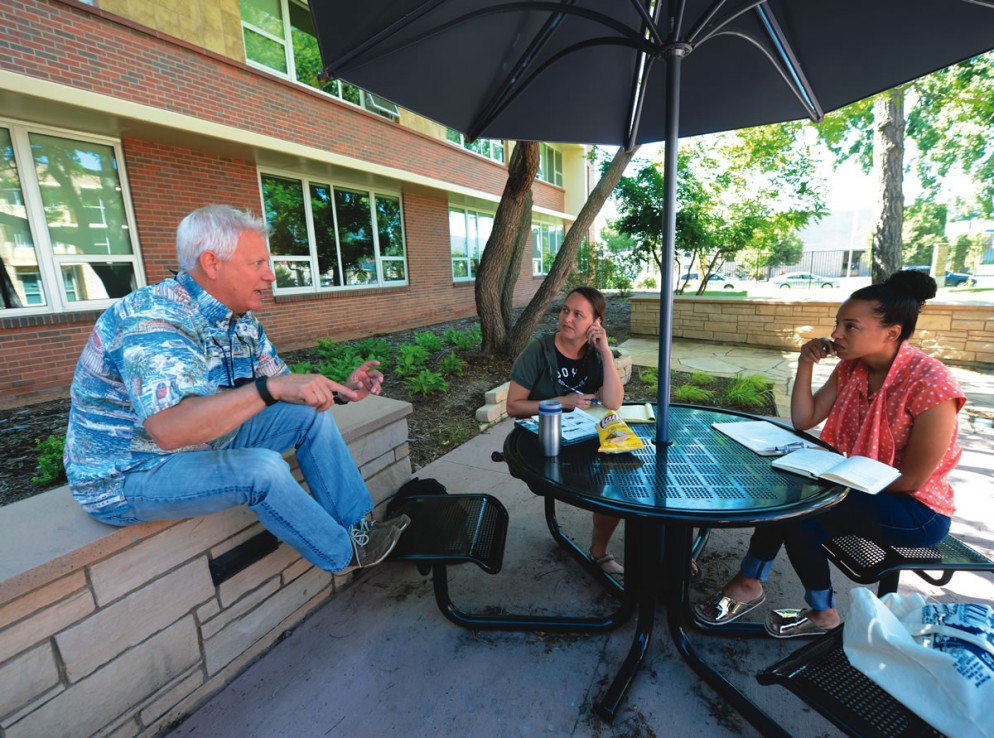When I drive through the CC campus I sometimes imagine going back, know-ing what I know now and doing it all again — in part for the intellectual stimulation and friendships, and in part because as an adult I have to arrange my own meals and I miss Rastall. A lot.
In July, CC offered a class for alumni, The Art of the Pitch. The premise was to “build your creative concept from the ground up,” to communicate that concept clearly, in a limited amount of time, captivating and selling others. The description of the class intrigued me, as did the idea of going back, if only for a few days. I wasn’t disappointed.
Patrick Bultema, executive director of Innovation@CC, and Steve Hayward, associate professor of English, taught in true CC style, imparting their knowledge, sharing their experiences, and pushing us to transform our learnings into our own interpretation. One of my favorite things about CC is how exposure to new content is complemented by translation into everyday inspiration. With that, here are some nuggets of inspiration I learned throughout — and tucked into my pocket for safekeeping.
Takeaway One: Sometimes ideas evolve. Sometimes ideas should go extinct. As we engage in new experiences, our ideas form, morph, and develop. Some of these ideas mutate into something more powerful and robust. Others, not so much. Sometimes an idea’s purpose is to sprout other ideas and then fade into the background. We should thank each for its contribution and then let it go.
Takeaway Two: Keep it simple, elegantly so. There is a turquoise sticky note on my office wall. It reads “Elegantly Simple.” I write curriculum for K-12 science classrooms — material that is taught in my absence. So it’s important that it’s simple enough to understand and implement, but complex enough to engage and inspire. On the second day of class, Patrick applied the idea of elegance in simplicity to the concept of a pitch. What you present to others has to be portrayed so simply they can not only understand the idea, but can also picture how it would work. When I verbally share a new idea, it’s like laying my brain on the table. Tangled, continually morphing,messy. Presenting an idea in an elegantly simple package takes meticulous planning and lots of practice. Our ideas have to stumble before they can stand.
Takeaway Three: New experiences lead to new opportunities. Steve, alongside a couple of fellow CC professors, host the radio show “Critical Karaoke,” a program that “uses music to offer a fresh take on issues and ideas confronting artists and audiences today.” Through my class pitch idea and our surrounding conversations, my interest in how access to language provides exposure to new ideas and opportunities to engage surfaced. Steve asked if I might want to contribute to the “Critical Karaoke” project. I accepted. A new opportunity for us both.
Takeaway Four: Expose yourself to things that make you uncomfortable. I entered expecting to sit back, listen, and learn. Which means I had totally forgotten the way educational experiences work at CC. My pitch idea was loosely developed, existing predominately in my head. Trying to accurately explain it out loud made me realize how knotted it still was. Clearly articulating ideas and being precise in your description is a bit painful. And I’ll admit, my idea wasn’t completely polished by the time I pitched it but the productive struggle reminded me of something: Pushing yourself makes you uncomfortable, but the resulting growth feels so good.
Thank you, CC. Again.
Rebecca Grainger is a science fellow at the Institute for Learning at the University of Pittsburgh. She works to make public education more accessible and engaging for all students regardless of ethnicity or socioeconomic level.
Discover more online: Read an update about Art of the Pitch as well as view a video featuring last summer’s participants at 2cc.co/art-pitch

